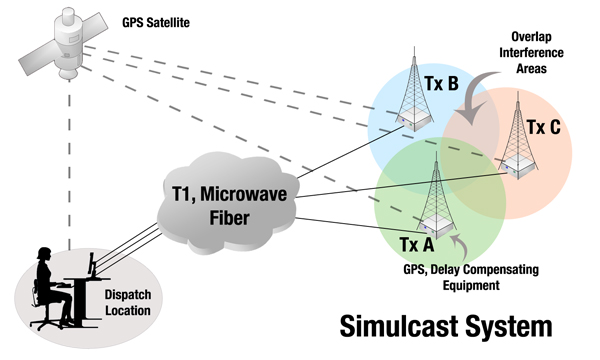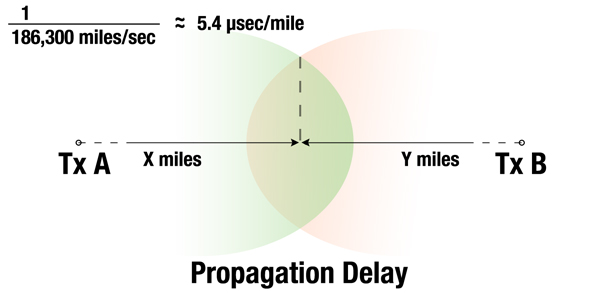Simulcast Radio Systems
Welcome to our August issue of GL's Consulting Newsletter. We focus on a unique communications technique used in public safety communications systems - "simulcast radio" . We think you will find this very interesting reading. In brief, simulcast systems are becoming more affordable and provide:
- Wide geographic coverage area with a uniform frequency plan
- Improved coverage in otherwise "dead spots", at the expense of some degradation in overlap areas
- Improved building penetration for portables
- Frequency efficiency by reuse
- Compatibility with old analog and new digital radio systems
- Simplicity of operation for dispatchers

Introduction
Public safety personnel (police, fire, bus, rail, and emergency) rely on seamless wide area radio communications coverage to effectively perform their daily tasks. Typically a city/country will need to serve several hundred square miles or more with a handful of radio channels. A dispatcher may need to reach anyone in the serving area. But engineering wide area radio coverage with limited radio spectrum and limited number of radio channels is not easy. Generally many transmitter / receiver sites are required to get the widest possible coverage for mobiles and portables, for improved voice and data quality, and for better building penetration.
Cellular systems use many small cells, small towers, and reuse frequencies in non-adjacent cells to achieve wide area coverage. This requires that individual radios be able to switch frequencies and the radio system be able to "handoff" from one base station to a neighboring base station as the radio user roams from one cell to the next.
This level of complexity is not always affordable or readily available to the public safety band. To achieve wide area radio coverage, public safety agencies divide the problem into two - "talk out coverage" and "talk in coverage"
.- "Talk out" coverage - is communications from a dispatcher to field personnel, or also called downlink coverage. Many solutions exist to achieve the widest possible "talk out" coverage, including
- Employing multiple transmitter sites
- Increasing transmitter power if FCC allows
- Raising the transmitting antenna height, or tower height, if FAA allows
- Directing the antenna patterns optimally
- Employing transmitter steering - the dispatcher (manual) selects the best transmitter site or the system selects it (automatic) - only one transmitter operating at a time
- Employing multicast transmission - transmission on multiple frequencies from multiple sites; requires additional frequencies and may require radio users to constantly change frequencies.
- Employing simulcast transmission (discussed further below)
"Talk in" coverage - is communications from field personnel to dispatchers, or also called uplink coverage. Possibilities for improving coverage here include:
- Multiple receiver sites with central "voting receivers"
- Pre-amplifiers at the top of a tower to boost the signal from low power portables
- Vehicular repeaters for portable talk-around coverage
Simulcast Transmission
"Talk-out" coverage can be greatly improved by simulcast transmission. Simulcast is the concatenation of two words "simultaneous" and "broadcast". It is the simultaneous transmission of audio on the same frequency from two or more sites. Wide area coverage is possible with multiple transmitters. Normally if two or more transmitters were to transmit the same signal, a receiver in the field would "lock" or "capture" the stronger of the signals. If the signals are within ± 10 dB of each other, the signals either constructively or destructively combine in the receiver. To ensure that they "constructively" add together requires complex "synchronizing" transmitter equipment such that the signals are transmitted at exactly the same time (within microseconds) of each other. The most important parameters that must be precisely matched among the transmitters are:
- RF carrier frequency to within a 1 Hz
- Audio phase to within 10 degrees
- Amplitude response to within 0.1 dB
- Audio delay to within 10 microseconds

Matching parameters requires digital transmission of voice to the transmitting site, delay compensating equipment at the transmitting sites, and very accurate timing references at each of the transmitter sites. Digital transmission is commonplace these days with T1, E1, digital microwave radio, and fiber widely available. Delay compensation equipment is required to compensate for the delay variation between the dispatcher and the various transmitter sites. Digital transmission also makes this relatively easy. When delay compensation is combined with GPS, then delay adjustment due to changes in the transmission path are also easily accommodated. Accurate timing references are used to control the RF carrier frequency and to accurately set the delay compensation equipment. GPS makes this possible. In order to avoid overdependence on GPS (the military may limit access during wartime), rubidium oscillators are also used in parallel to GPS.
In summary, simulcast systems provide wide geographic coverage with a uniform frequency plan, improved coverage in otherwise "dead spots", at the expense of a small degradation in overlap areas, improved building penetration for portables, frequency efficiency thru reuse, and simplicity of operation for dispatchers.
Here are some simulcast projects that GL has worked on:
Radio Communications for Downtown Philadelphia and its Vicinity
GL Communications provided system design for radio communications of aboveground, garage repeaters and underground systems in-tunnels for SEPTA's transit network. This included technical specifications for a Simulcast trunked radio system.
Tunnel Radio Communications for the Baltimore Metro Subway
GL Communications developed design and technical specifications for the Baltimore Metro Subway to extend the system-wide radio communications in the tunnel and underground stations. We also offered design services for their trunked simulcast radio system.
Simulcast Trunked Radio System for a Mass Transit & Public Safety System
A Transit and Public Safety system requires a robust land mobile radio communications system for its day-to-day operations as well as routine system maintenance. The system must meet the growing concerns for the homeland security and provide best service to its patrons. These challenges are achievable by careful design and implementation of a modern simulcast trunked radio system which provides seamless system-wide radio coverage.
We hope that you will enjoy reading these newsletters as much as we like participating in these projects. Future issues will highlight GL's support for projects such as:
- WiMAX and WiFi technologies
- HVAC and Environmental Control of Outdoor Equipment Cabinets
- Metro Fire Security Management System
- Agency-wide Customer Information System for a Transit Network
 Back to Consulting Services Newsletters Page
Back to Consulting Services Newsletters Page